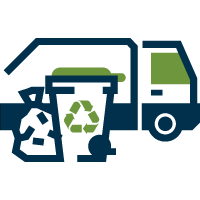Rubbish Collection Mandurah is a vital part of waste management. It is important to keep rubbish collection as efficient and safe as possible to reduce waste and avoid environmental hazards.
Residents should place their bins out for collection on their specified day and week, depending on whether they choose the fortnightly option or a four-week cycle. Your specific collection day and week can be found on the side of your bins.

Refuse sacks are a convenient way to collect rubbish from your home or office. They are lightweight and durable and can help keep waste bins clean and free from odors. They are available in various sizes to suit both commercial and domestic use. In addition, they are an economical option for lining garbage containers.
The most popular type of waste bag is black and is used for general household waste. These bags are designed to be leakproof and strong, ensuring that they won’t tear or puncture. Many of these bags also have additives to help mask unpleasant odours.
A variety of different sizes are available, from small to large. Larger bags are ideal for larger waste containers, and they have a thicker material than smaller bags to make them more suitable for heavy loads. Many of these bags are made from LDPE, which offers good tensile strength and puncture resistance. These bags are great for a wide range of items, including food waste and office waste.
In addition, you can find special trash bags that are made of oxo-biodegradable plastic. These are designed to break down in a composting plant, which is important for organic waste disposal. These bags are ideal for food waste, animal waste, and other organic materials. These bags are also great for containing wet or messy waste, and they are more environmentally friendly than traditional bags.
These bags can be purchased from many stores and come in a range of thicknesses. Some come with closure mechanisms, such as tie tops, drawstrings, or flat tops, to seal the bags once full. These closures are designed to prevent waste from spilling out of the bag and to allow easy handling with minimal contact. They are also designed to fit a variety of different types of bins, including wheelie bins and pedal bins.
Containers are used for storing solid wastes until they are collected for final recovery or disposal. They are available in various sizes to suit different locations and sources of waste generation, such as residential colonies, commercial establishments, offices and institutions. They can be either small or large and can be made of plastic materials, metals, deep pressed steel or a combination of these.
The containers should be durable, strong and easy to clean. The size should also be suitable for the amount of waste generated. Moreover, the containers should be covered to avoid rain water from entering the wastes which accelerates the rate of decomposition and produces obnoxious odours. It is also important to keep in mind that the containers should be kept at a reasonable distance from each other to minimize the risk of waste transfer.
Waste containers come in many shapes and sizes and are a common sight in urban areas. In the past, mounds of trash bags stacked on sidewalks awaited pickup, but they created problems like split bags leaking into the street and attracting rodents that were looking for a food source. Today, modern recycling systems use garbage containers to make it more efficient and safer.
A typical residential garbage container consists of a bin that is about 40 inches high and 18 to 24 inches wide. It is typically used for household trash, but may be used to collect industrial and construction debris. It can be easily moved by a rubbish truck and is usually set out at the curb. It has a lid that is operated by a foot pedal, which frees the user from touching the bin with their hands. Lillian Moller Gilbreth, an industrial engineer and efficiency expert, invented this type of bin in the 1920s.
Whether it’s a waste container or an entire recycling system, labels are critical for proper rubbish collection. They help employees and visitors identify the correct containers for each type of waste, and they make it easy to communicate your trash policies in an eye-catching way. Labels can also be used to track hazardous materials in the workplace. These labels are printed on the front of fume hoods in most labs and departments and include all of the relevant information required by the DOT.
These labels are often laminated for added durability and to resist chemical exposure, UV light and other environmental factors. They are available in a wide variety of sizes, colors and legends to match any facility’s needs. Some even feature the generator’s name, EPA identification number, and hazard statement. In addition to being durable, these labels are reusable and are made of a polymer that does not easily peel or fade over time. They can be applied to a variety of surfaces, including plastic and metal containers, for use in waste transportation applications.
Trash and recycling bins are usually located near each other in a facility, making it convenient for workers to place their waste in the right receptacle. But it’s important to keep in mind that trash and recycling bins should be labeled with clear images of the items that should go in each one. These labels will help employees and visitors understand the differences between waste streams and prevent contamination.
A great way to promote your recycling program is by using standardized labels, which are available for free to businesses and individual residents in These labels align with philosophy of consistency and communication when it comes to recycling stream colors and labels. The standardized labels are also designed to encourage fewer trash and recyclables in the same stream, which is good for the environment.
During the holidays, households throw away 30% more trash. The extra waste puts more pressure on grey bins, so it’s important to maximize recycling in your blue, brown, and green bins and double wrap food scraps and nappies to minimize odor and contamination. You can also request a larger bin through the council if you produce a lot of rubbish.
Putting rubbish out on the wrong day or in flimsy bags leads to litter-strewn streets. To avoid this, make sure to put your rubbish out before 6am on your collection day – or after 9pm the evening before. You should also use strong refuse sacks and not flimsy carrier bags.
Once collected, rubbish is sorted and sent to a waste processing facility. It undergoes pre-treatment to remove large items that could damage the processing equipment and to separate organic waste from inorganic materials. Then, the waste is processed and recycled or disposed of.
Recycling is a critical part of the waste management process. It enables us to use waste materials to make new products and reduces the amount of harmful waste that ends up in landfills. It also saves energy, cuts down on the need for raw materials, and protects the environment.
Many cities and towns provide convenient recycling options for their residents, such as centralized bins where residents can place their recyclables. These are usually marked with clear symbols that indicate which materials can and cannot be recycled. There are also programs that allow residents to take their yard waste and food scraps to community composting facilities.
There are many ways to recycle, including separating paper, plastic, metal, glass, and other materials. However, it is important to keep in mind that some items cannot be recycled, such as paint, pesticides, fertilizer, and other household chemicals. These should be taken to household hazardous waste collection sites or events.
Using recycled materials to create new products can save energy, reduce greenhouse gases, and cut down on industrial pollution. It can also help conserve the environment, which is a top priority for most governments. Recycling has become a major concern since the late 1980s, when environmental concerns became widespread.
Despite the popular myth that there is no such thing as a trash-free world, most of our discards end up being buried, burned, or recycled into new materials. Some of the most commonly recycled items include aluminum cans, glass bottles, plastic containers, and paper. Some of these recycled materials are reused to produce construction products, while others are used in electronics and other consumer goods. Those that cannot be recycled are incinerated or deposited in landfills.

